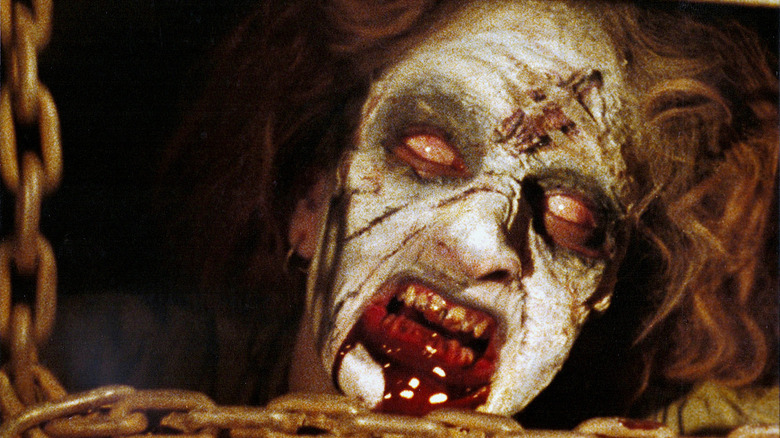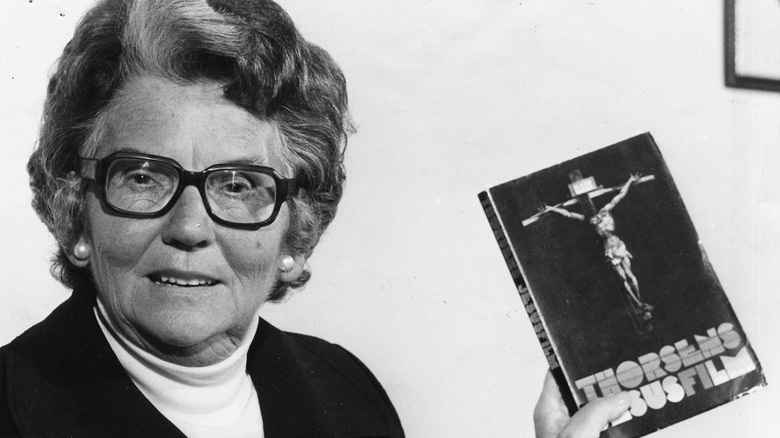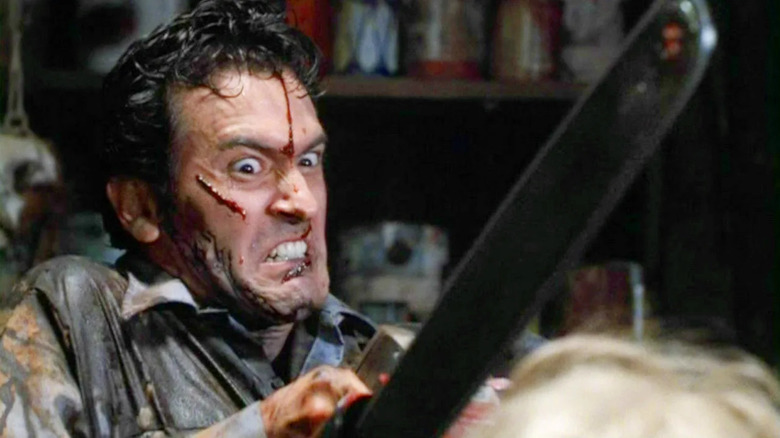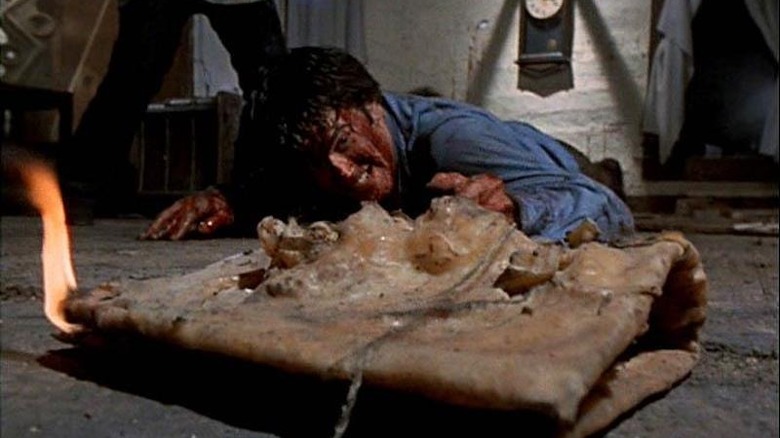How Sam Raimi Took On The Censors And Changed Horror Forever
Sam Raimi has returned to the big screen this week with the newest movie in the Marvel Cinematic Universe, "Doctor Strange and the Multiverse of Madness." It's a major step back to the world of blockbusters for the director who helped to define the modern superhero movie with his "Spider-Man" trilogy. But for many film lovers, Raimi will forever be a maestro of horror, the man responsible for one of the all-time great gore trilogies of the 20th century: "The Evil Dead."
As a mere 21-year-old, Raimi gathered together some of his best friends to make his first feature film outside of college. With a tiny budget, an exceedingly difficult shoot, and some boundary-pushing prosthetics, they made what many consider to be greatest first zombie film of all time. Even critics loved "The Evil Dead." Stephen King called it "the most ferociously original horror film of the year" and the Los Angeles Times declared it to be an "instant classic" that was "probably the grisliest well-made movie ever." A simple story of five students who accidentally wreak havoc on their rural cabin with the Book of the Dead, demonically possessed trees, and murderous zombie-like creatures took the midnight movie circuit by storm. It also unleashed a barrage of controversy that highlighted one of the most vicious censorship campaigns of the era.
In the late 1970s and early 1980s, home video became increasingly commonplace in households across the U.K. The devices were still expensive but the popularity of watching films from the comfort of one's home predictably exploded. Major studios still fought over the growth of VHS and whether or not to release their major cinema releases in this format (piracy was still a major fear and it would take years for money-making titles like "E.T." and "Raiders of the Lost Ark" to get video premieres.) But this left a gap in the market for the kind of stuff that didn't get theatrical distribution. Its newness meant that it was also decisively less regulated a market than cinema releases, which had to go through the ratings boards to receive certification. So, if you were a lover of pornography, horror cinema, or just good old-fashioned B-movie schlock, the world of VHS was your oyster. Specialist video magazines and sellers took advantage of this to promote the likes of "The Driller Killer" and "Cannibal Holocaust." But as these films garnered further attention from the public, they became the focus of much fear, and a movement was soon born to get rid of them.
Video nasties
Mary Whitehouse was a British campaigner against what she saw as the growth of moral indecency in modern entertainment. She led well-funded, very loud, and extremely hypocritical campaigns against everything she considered bad for the kids. This mostly meant that she got a lot of airtime for preaching homophobia and lying about films she hadn't actually seen. She infamously sued the makers of the play "The Romans in Britain" for gross indecency because she thought an on-stage depiction of male rape was real (she hadn't actually seen the play and, no, an actor wasn't literally raped eight shows a week. Whitehouse lost the case then declared that God would deal with her legal fees). It didn't take long for this new age of horror on video to capture her attention.
Whitehouse sparked off a public campaign and coined the term "video nasty" to describe the films that fell under the vast umbrella of her wrath. Soon, she had a lot of powerful people on her side, from the right-wing tabloid The Daily Mail to various Conservative politicians. Member of Parliament Graham Bright led the charge in the British House of Commons, saying, "I believe there is research taking place and it will show that these films not only affect young people but I believe they affect dogs as well."
Soon, video sellers and casual movie fans were being prosecuted for selling or releasing tapes that were considered obscene. Shops were raided, as were people's homes. The Director of Public Prosecutions released a list of 72 films that they believed to violate the 1959 Obscene Publications Act, which defined certain materials as examples of illegal obscenity. Eventually, a second list was released that contained an additional 82 titles which were not believed to lead to obscenity convictions but could nonetheless be confiscated under the Act's vague protocols. "The Evil Dead" was on the list.
A symbol in the battle for horror freedom
What makes the presence of Raimi's film on the video nasty list so fascinating is that it had originally passed the requirements for a cinema release, albeit with cuts made. Raimi proudly threw every violent and bad taste element he could think of into his movie, admitting that he didn't really care about the threat of censorship. Yet even he couldn't have predicted how quickly "The Evil Dead" would become a symbol in the battle for horror freedom. Whitehouse and her supporters soon claimed that kids who saw the film would try to recreate scenes in real life, most notably the moment where a possessed character stabs a pencil into someone's ankle. There's no recorded proof that any British child watched "The Evil Dead" then copied this attack. There was also no hard evidence that kids were watching these video nasties with the regularity and zeal that Whitehouse insisted was the dark reality of the matter. Indeed, there were interviews with gleeful-looking schoolchildren bragging about having seen all of these nasties, some of which didn't actually exist.
"The Evil Dead" was one of many films now considered classics that made the video nasties list. It was also one of several titles to be censored after initially being declared suitable for cinematic release (this classification duty fell under the auspices of a different group, hence the disconnect) — films like "Phantasm," David Cronenberg's "Rabid," and the fun and very silly Andy Warhol-produced "Flesh for Frankenstein." Soon, it seemed as though movies being seized by the police because their titles sounded weird or because it had the vaguest hint of adult content. In one infamous example, the decidedly un-violent Dolly Parton musical "The Best Little Whorehouse in Texas" was grabbed in a raid, with one confused police officer believing it had to be pornographic because of the title.
Soon, this overreach inspired public backlash, but it still took many years before some of these films could receive home releases. "The Evil Dead" didn't get re-released in an uncut form until 2001, 20 years after it initially premiered. By that point in time, Raimi was a major name in Hollywood and his status as a cult icon long since secured. "The Evil Dead" still holds up as a frenetic and merrily fun zombie horror that throws everything at the wall to see what sticks. The gore is still gross, the jokes still funny, and those infamous set-pieces (hello, tree rape) still able to shock.
Losing the battle, winning the culture war
It's pretty rare in both America and the U.K. for movies to be outright banned. Some films have been denied certification by ratings boards, effectively making it impossible to receive a theatrical release, but such titles typically make a few cuts and move on, which is what happened in 2011 to "The Human Centipede 2 (Full Sequence)." In the internet age, getting a hold of such works is easier than ever. Eroticized sexual violence and pervasive anti-semitic imagery have seen some films be denied ratings in recent years. Nowadays, the question of censorship in cinema is less prominent but no less a continuing concern. The Motion Picture Association of America (MPAA) isn't as moralistic as it used to be but still rates consensual sex higher than blood fests. Bad faith hysteria still runs rampant, now packaged as part of a so-called "culture war," although the newer targets are films with diverse casting and vaguely progressive ideals rather than dismembered limbs.
One wonders how Raimi would respond to such an environment if he were given some real studio freedom and the budget to match. "The Evil Dead" seems tame to many horror nerds in 2022 but its legacy truly matters in so many ways. The video nasty panic reminds us that it doesn't take much to stir up an old-school censorship drive among those who think that art of all kinds shouldn't be viewed on its own terms.
Fortunately, while it took Raimi a few years of battle losses, he fully won the war. He's one of the most influential forces for an entire generation of horror. We wouldn't have Edgar Wright without Raimi, or Peter Jackson. The face of cinema as we know it wouldn't exist had Raimi not made chaos in the woods with his friends and the Book of the Dead. No censor can destroy that.



